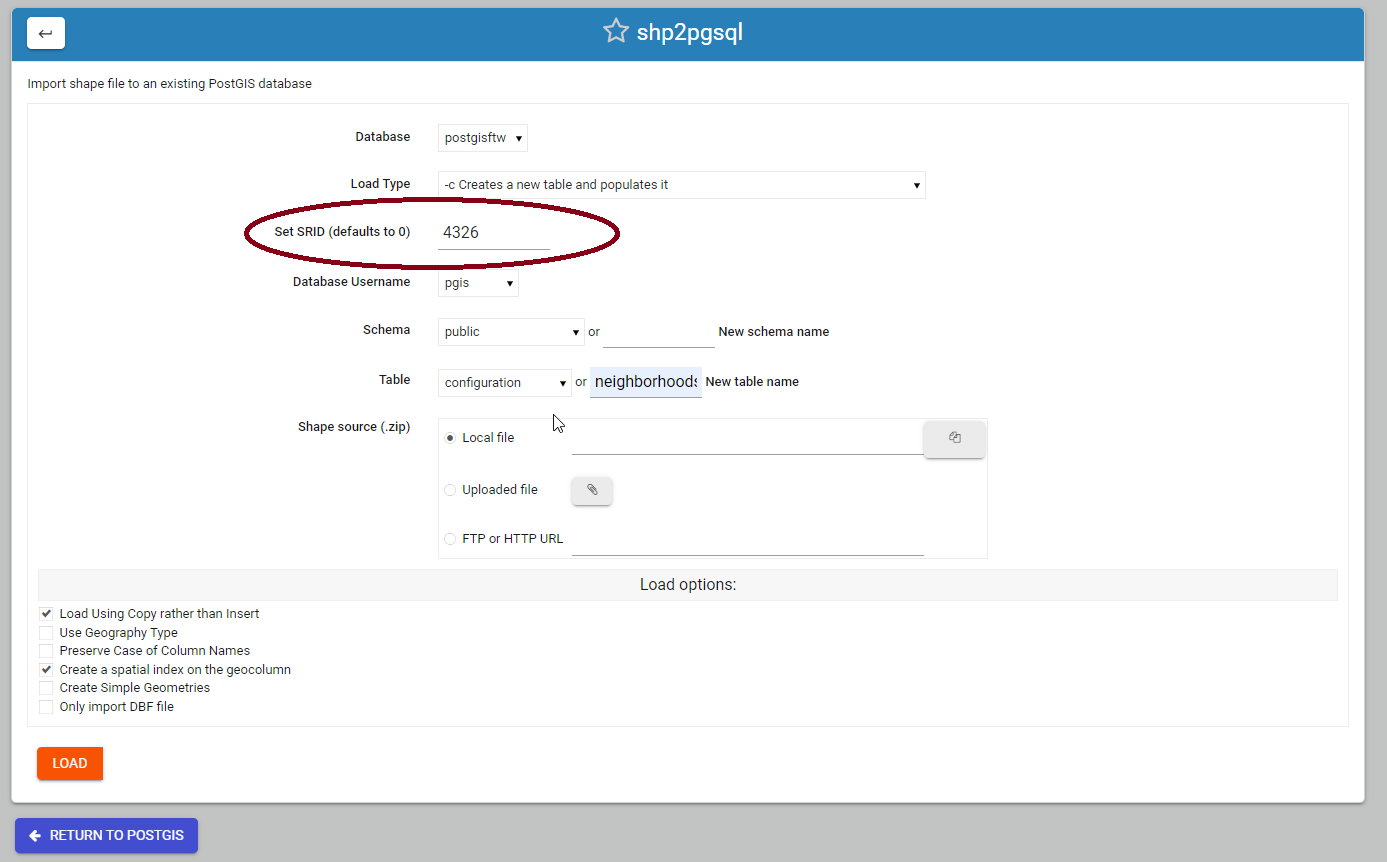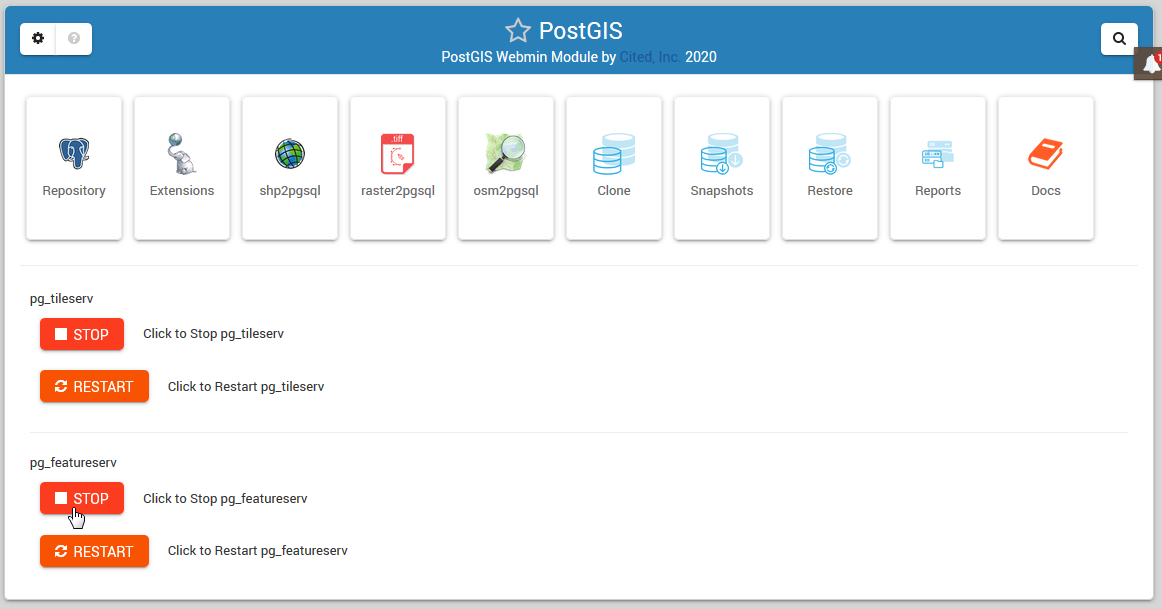pg_featureserv¶
Table of Contents
About¶
pg_featureserv is produced by Crunch Data (https://www.crunchydata.com/)
The documentation and examples provided are extensive (https://access.crunchydata.com/documentation/pg_featureserv/latest/)
We’ll confine ourselves below to the usage and layout of the service in GeoSuite
pg_featureserv¶
pg_featureserv is installed as a systemd service during installation.
The service can be started and stopped via command line or Webmin.
The service file contents are show below.
[Unit]
Description=PG FeatureServ
After=multi-user.target
[Service]
User=pgis
WorkingDirectory=/opt/pg_featureserv
Type=simple
Restart=always
ExecStart=/opt/pg_featureserv/pg_featureserv --config /opt/pg_featureserv/config/pg_featureserv.toml
[Install]
WantedBy=multi-user.target
The file is installed at:
/etc/systemd/system/pg_featureserv.service
Access¶
pg_featureserv runs of port 9000 and can be accessed at http://doamin.com:9000
If you have enabled SSL (see below), it can be accessed at https://domain.com:9001
You can change the port via the pg_featurserv.toml file located under /opt/pg_featurserv/config
Database¶
On installation, a database is created called postgisftw.
This database contains the demo data.
A user pgis is also created and given permission to the database.
The password for pgis is displayed at the end of installation as well as saved to /root/auth.txt
Loading Data¶
When loading data to any database for which you will use pg_tileserv, you MUST set a SRID
Without a declared SRID, pg_featureserv will not pick up the table.


Structure¶
pg_featureserv is installed by default at
/opt/pgfeatureserv
The directory structure is show below
/opt/pg_featureserv
├── LICENSE.md
├── README.md
├── assets
│ ├── api.gohtml
│ ├── collection.gohtml
│ ├── collections.gohtml
│ ├── conformance.gohtml
│ ├── fun_script.gohtml
│ ├── function.gohtml
│ ├── functions.gohtml
│ ├── home.gohtml
│ ├── item.gohtml
│ ├── items.gohtml
│ ├── map_script.gohtml
│ └── page.gohtml
├── config
│ ├── pg_featureserv.toml
│ └── pg_featureserv.toml.example.save
└── pg_featureserv
Configuration File¶
On installation, the pg_featureserv.toml configuration file is updated to include the postgisftw connection inforation
DbConnection = "postgresql://pgis:G84iwLdL9jeyA7IiwkTmWhyHwKR41Qxz@localhost/postgisftw"
Enable SSL¶
To enable SSL on pg_featureserv, follow the steps below
1. Copy the fullchaim.pem and privkey.pem files from letsencrypt to /opt/pg_featureserv
cp /etc/letsencrypt/live/domain.com/fullchain.pem /opt/pg_featureserv/fullchain.pem
cp /etc/letsencrypt/live/domain.com/privkey.pem /opt/pg_featureserv/privkey.pem
2. Change to the /opt/pg_featureserv directory and chown the owner of the chain and key files to user pgis
cd /opt/pg_featureserv
chown pgis:pgis fullchain.pem
chown pgis:pgis privkey.pem
3. Find the following lines in /opt/pg_featureserv/config/pg_featureserv.toml
# IP ports to listen on
HttpPort = 9000
# HttpsPort = 9001
4. Update the lines to below
# IP ports to listen on
# HttpPort = 9000
HttpsPort = 9001
5. Find the following lines in /opt/pg_featureserv/config/pg_tileserv.toml
# TlsServerCertificateFile = ""
# TlsServerPrivateKeyFile = ""
6. Update the lines to below
TlsServerCertificateFile = "fullchain.pem"
TlsServerPrivateKeyFile = "privkey.pem"
7. Restart pg_tileserv to pick up changes
service pg_featureserv restart
or use the Restart button in the control panel
You should now be able to access pg_tileserv via:
The postgisftw Database¶
As part of the GeoSuite installation, a database, user, and password are created.
This database, postgisftw, is actually the demo database created for pg_tileserv, but we use it throughout the tutorials.
To connect to the database via SSH:
- su to user postgres:
su - postgres
- Start pgsql
postgres@demo:~$ psql
psql (15.3 (Ubuntu 15.3-1.pgdg22.04+1))
Type "help" for help.
- List database using \l This will provide a list of database, as well as owners:
postgres=# \l
List of databases
Name | Owner | Encoding | Collate | Ctype | ICU Locale | Locale Provider | Access privileges
------------+----------+----------+---------+---------+------------+-----------------+-----------------------
geostore | postgres | UTF8 | C.UTF-8 | C.UTF-8 | | libc |
postgisftw | pgis | UTF8 | C.UTF-8 | C.UTF-8 | | libc |
postgres | postgres | UTF8 | C.UTF-8 | C.UTF-8 | | libc |
template0 | postgres | UTF8 | C.UTF-8 | C.UTF-8 | | libc | =c/postgres +
| | | | | | | postgres=CTc/postgres
template1 | postgres | UTF8 | C.UTF-8 | C.UTF-8 | | libc | =c/postgres +
| | | | | | | postgres=CTc/postgres
(5 rows)
(END)
- Connect to the postgisftw datbase using the \c command
postgres=# \c postgisftw
You are now connected to database “postgisftw” as user “postgres”.
- List the tables in the database using the \dt command
postgisftw=# \dt
List of relations
Schema | Name | Type | Owner
--------+-------------------+-------+----------
public | configuration | table | pgis
public | countries | table | pgis
public | pointsofinterest | table | pgis
public | spatial_ref_sys | table | postgres
public | ways | table | pgis
public | ways_vertices_pgr | table | pgis
(8 rows)
postgisftw=#
